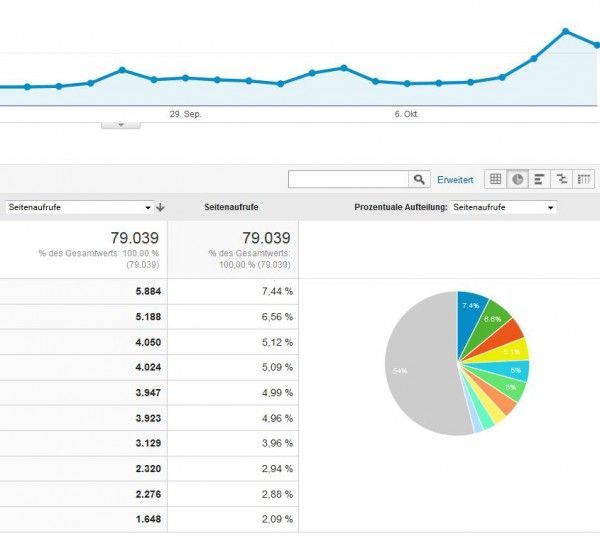5 steps to an online marketing concept
A marketing concept is an important basis for the successful marketing of your products. This is especially true for marketing on the Internet, so that a suitable online marketing concept is becoming increasingly important. This concept summarizes all the essential information about the online marketing of a company and puts the relevant factors in a meaningful and promising relationship. In this article, I show the five most important steps in creating an online marketing concept.
Are you interested in success factors, key figures and innovative concepts in e-commerce? Then you should immediately use the short line to Prof. Richard Geibel: Tel. 0221 973 199 722 or mail info@ecommerceinstitut.de.
Content

In the digitalization, in which more and more advertising and more and more communication takes place online, new challenges but also new opportunities arise when creating a marketing concept. The additional possibilities of the Internet as an innovative communication channel should be taken into account when creating the marketing concept in order to achieve competitiveness or even competitive dominance based on existing marketing innovations.
The online marketing concept – the basics
In order not to be subject to a general confusion of terms, a clarification and delimitation of important terms is useful at first. The term “marketing concept” summarizes all essential considerations and planning in marketing. Every marketing concept starts with the situation analysis, the marketing goals and the marketing strategy. On the operational level of marketing measures, marketing budget and finally marketing controlling, the implementation of the strategy and the review of the effectiveness and efficiency in marketing is checked. This results in an outline for every marketing concept that is not only helpful but also manageable and, in its compactness, significantly supports the conceptual work in marketing.
The steps for creating a digital marketing concept are:
- Marketing goals
- Marketing strategy
- Marketing measures
- Budget and
- Web analytics.
First step towards an online marketing concept – marketing goals in the digital age
In marketing communication, the online channel and the ever-increasing importance of online marketing have brought about substantial changes. On the one hand, the multiplication of marketing tools, the fragmentation of target groups, and the increase in the intensity of competition in online marketing and e-commerce have noticeably increased the complexity of marketing. On the other hand, technology-based solutions for measuring the effectiveness of marketing measures, segmentation and more precise addressing of target group segments mean opportunities for increasing efficiency and thus opportunities for increasing marketing success.
Success factors in online marketing
The key success factor in digital marketing is focus and prioritization. General marketing concepts or goals are certainly not suitable for achieving effectiveness in digital marketing. Therefore, special care is required when deriving marketing objectives from the company’s situation analysis in order to achieve the greatest possible concretization and detail at the objective level, which makes significant contributions to the implementation of the objectives.
Quantify online marketing goals
The quantification of marketing objectives makes a significant contribution to focus. Due to the significantly increased measurability of the results of marketing measures, this is a decisive contribution to increasing efficiency. The generation of key figures in online marketing, which is determined by the WebAnalytics functional area, allows marketing goals and measures to be quantified across the entire marketing process.
This means that quantitative sales targets can be derived from the situation analysis, which considers the company in the context of its markets and its performance potential, and these are the starting point for the development of marketing targets. For the derivation of marketing targets from the sales targets, the result of the situation analysis must also be the definition of target group segments and their accessibility via different marketing channels. In this way, an assignment of sales segments to target group segments and finally to marketing channels can be made. Here is an example:
- Total turnover: 1.000.000 Euro
- A Segment: 400.000 Euro
- B Segment: 200.000 Euro
- C Segment: 200.000 Euro
- A Channel – search engine optimization: sales target 400.000 Euro
- B Channel – search engine marketing: revenue target 200.000 Euro
- C Channel – Direct access: 200.000 Euro.
Channel-specific budgets can be derived from the allocation of segment sales to online marketing channels. The following objectives and budgeting can be determined for search engine marketing with the help of suitable benchmarks or assumptions:
- Search engine marketing turnover: 200.000 euros
- Shopping cart: 50 euros (net, after returns)
- from this, follows the conversion goal of 4.000 conversions
- Conversion rate 5%
- from this follows the target range of 80.000 page visitors
- CPC 0,5 euros
- this results in a budget for search engine marketing of EUR 40.000
Second step to the online marketing concept – the marketing strategy
While the marketing goals identify potentials from the situation analysis of the company and determine orientation points for the future, the marketing strategy describes the path to the goal.
Strategic online marketing objectives
Just like the marketing objectives, the marketing strategy should also be channel-specific to account for the diversity of channels. The marketing strategy is closely related to corporate strategy. Thus, assuming Porter’s generic strategy types, an online marketing strategy should be defined for price leadership and quality leadership. The mechanisms of the online channel require a dominance orientation for price competition, which requires a very clear focus on online marketing. This is not only functional but also financially relevant, as the reach required for cost and price leadership can only be achieved through high online marketing spendings.

In contrast, quality leadership may be more achievable, even in a long-tail niche, through content-driven online marketing, where online branding occurs, particularly through presence on a topic in many social media, which in turn drives reach and conversions.
Blue Ocean Strategy in Online Marketing
Other strategy types include an online brand strategy or a Blue Ocean strategy. While the Blue Ocean strategy is characterized by a reinterpretation of a product – a standard example is Cirque de Soleil- the brand strategy is the objective to transfer an existing brand into the online channel or to establish a new brand online. In the latter case in particular, the use of conventional advertising media such as TV is likely to be worth considering.
Third step to the marketing concept – the marketing measures
Once a strategic definition has been made, the next step is to translate it into marketing measures. This takes place at the operational level and implements the marketing objectives defined in the short-term and medium-term business plan. Here, the strategic determinations require the selection of specific instruments, which should be used in a very wide range, especially in the dominance-oriented price leader strategy.
The most relevant and typical instruments in online marketing are:
- Search engine optimization
- Search engine advertising
- Display advertising
- Affiliate advertising
- social media marketing
- Content and video marketing
The choice of measures and instruments depends on the strategy and the target group or target group segment. Last but not least, the personnel measures of the company are also decisive as to which instruments can be processed.
In principle, the balance of a portfolio within the marketing concept should be taken into account when compiling the measures. Sole dependence on one instrument such as search engine optimization – even if this is certainly the most attractive measure – means too great a risk due to the extreme dependence on the Google algorithm.
The online marketing portfolio
A balanced online marketing portfolio, on the other hand, hedges against system risks, reduces online marketing effort, and also helps the company to participate in the development of as many instruments as possible.
In addition to the balance of measures, the temporal aspect of the effect of online marketing instruments must also be taken into account. While some instruments -such as search engine marketing- lead to results in the short term, others such as search engine optimization or even branding with the help of social media marketing require a longer breath. First of all, this implies that long-term measures must be started early, while short-term instruments can be handled more flexibly. In the case of social media activities, it must not be overlooked that they have a life character, i.e., that they must be published when the target group is online.
Fourth step to the marketing concept – budget planning
Detailed budget planning is a key success factor, especially with a very diverse set of online marketing tools. Budget planning is made easier if historical values are available, which are decisive for determining the use of funds.
Decisive for the use of budget funds is above all the average contact price, the conversion rate and the number of visitors to be derived from this, as already explained above.
Budget planning as part of the digital marketing concept should always be channel-related and flexible in order to be able to take into account shifts in reach and price within the channels. If it turns out that contacts can be reached more cheaply and with the same conversion quality in one channel than in another, it should be possible to reallocate the funds at short notice. The efficiency of the measures in the online marketing concept must also be reviewed on an ongoing basis in order to be able to react quickly in the event of a drop in reach and conversion.
Fifth step to the digital marketing concept – WebAnalytics
This fifth step – which can also be referred to as online marketing controlling – determines key online marketing KPIs such as unique visitors, average shopping cart sizes, pages/visits and conversion rates for individual channels on a daily basis. A web analytics solution such as Google Analytics, etracker or Piwik is used for this purpose. In their own evaluations and dashboards, the online marketing expert receives comprehensive insights into the effect of the measures implemented and the achievement or non-achievement of the planned contact and sales figures. Since the objective of all measures is to achieve sufficient contribution margins, a direct link to corporate controlling is crucial.

It is becoming increasingly important that the customer journey can be traced. This describes the process that a customer goes through on the website until the lead or conversion. The aim of exploring conversion paths is to increase the efficiency of the process from the customer’s point of view in order to increase the probability of conversion and reduce the conversion effort.
Web analytics must be included in the planning of an online marketing concept from the outset, as only those measures can be used effectively where the goals and effects can be verified. This applies in particular to the integration of non-digital advertising channels. These are interesting and relevant if they help reach the intended target group segments and if they offer competitive contact costs. With increasing competition in the online channel and thus rising contact costs, this is an increasingly relevant aspect. Consequently, before using these channels, it is helpful to have a model that can be used to verify the success of the offline channel from measurable events.
Conclusion
Creating a comprehensive digital marketing concept enables companies to incorporate the potential of the online channel into their marketing. Ultimately, it is safe to assume that online marketing is already indispensable in the digital transformation. Therefore, early creation of an online marketing concept is not only a success factor, but also a competitive factor.
Photo and author: Prof. Dr. Dominik Große Holtforth